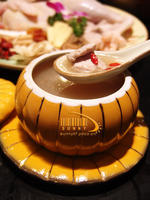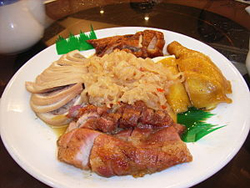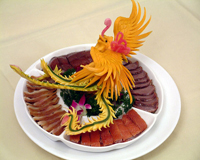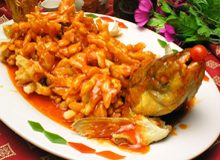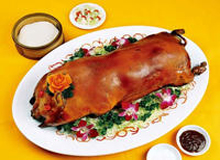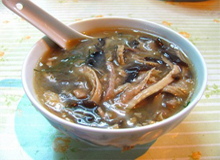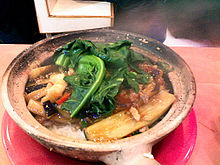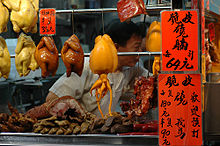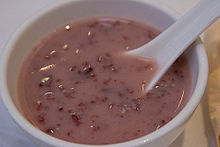
Cantonese cuisine comes from Guangdong province and is one of the Eight Culinary Traditions of Chinese cuisine. Its prominence outside China is due to the great numbers of early emigrants from Guangdong. Cantonese chefs are highly sought after throughout China. When Westerners speak of Chinese food, they usually refer to Cantonese cuisine.
| | Cantonese cuisine comes from Guangdong province and is one of the Eight Culinary Traditions of Chinese cuisine. Its prominence outside China is due to the great numbers of early emigrants from Guangdong. Cantonese chefs are highly sought after throughout China. When Westerners speak of Chinese food, they usually refer to Cantonese cuisine. Cantonese cuisine takes fine and rare ingredients and is cooked with polished skills and in a dainty style. It emphasizes a flavor which is clear but not light, refreshing but not common, tender but not crude. In summer and autumn it pursues clarity and in winter and spring, a little more substance. The sauteed dishes always rely upon exquisite presentation involving cutting and carving skills. |
-------------------------------------------------------------------------------------------------------------------------------------------------------------------------
Background
| Guangdong has long been a trading port and many imported foods and ingredients are used in Cantonese cuisine. Besides pork, beef and chicken, Cantonese cuisine incorporates almost all edible meats, including offal, chicken feet, duck's tongue, snakes, and snails. However, lamb and goat are rarely eaten, unlike in the cuisines of northern or western China. Many cooking methods are used, with | Siu mei platter | steaming and stir frying being the most favoured due to convenience and rapidity. Other techniques include shallow frying, double steaming, braising, and deep frying. For many traditional Cantonese cooks, the flavours of a finished dish should be well balanced and not greasy. Spices should be used in modest amounts to avoid overwhelming the flavours of the primary ingredients. |
There is no widespread use of fresh herbs in Cantonese cooking, in contrast with their liberal use in other cuisines such as Sichuan, European, Thai or Vietnamese. Garlic chives and coriander leaves are notable exceptions, although the latter are usually used as mere garnish in most dishes.
-------------------------------------------------------------------------------------------------------------------------------------------------------------------------
Features
| | In 1986, Prince Philip commented on Chinese eating habits at the World Wildlife Fund conference: "If it has four legs and is not a chair, if it has two wings and flies but is not an aeroplane, and if it swims and is not a submarine, the Cantonese will eat it." Despite having the quote presented to a notable organisation, it has also appeared in books such as "The Most Stupid Words Ever Spoken" as it is deemed by some Westerners as a prime example of a lack of understanding of foreign culinary traditions in the Western world. However, some sources point out that this is a modern saying used by the Chinese from other regions in reference to Cantonese culinary habits. |
Typical menu here can ultimately embody these characteristics:
| | | |
| Chrysanthemum fish chefs with adept cutting techniques shape the fish like chrysanthemums, each individual morsel being convenient to enjoy with either chopsticks or forks. | Braised Snake porridge choose rare meat of cobra, grimalkin, and pullet, braised elaborately, also called 'Dragon and phoenix contending' (Long Feng Dou). | Roast suckling pig a famed dish with rather long history, golden and crisp exterior, and tender meat, with dense aroma. |
-------------------------------------------------------------------------------------------------------------------------------------------------------------------------
Foods
Little pan rice
| | Little pan rice are dishes cooked and served in a flat-bottomed pan (as opposed to a round-bottomed wok). Usually this is a saucepan or braising pan (see clay pot cooking). Such dishes are cooked by covering and steaming, making the rice and ingredients very hot and soft. Usually the ingredients are layered on top of the rice with little or no mixing in between. Many standard combinations exist. |
Siu mei & Lou mei
| | Siu mei is essentially the Chinese rotisserie style of cooking. Unlike most other Cantonese dishes, siu mei consists of meat only, with no vegetables Lou mei is the name given to dishes made from internal organs, entrails and other left-over parts of animals. It is widely available in southern Chinese regions. All Cantonese-style cooked meats, including siu mei, lou mei and preserved meat can be classified as siu laap. |
Dessert
| | After the evening meal, most Cantonese restaurants offer tong sui, a sweet soup. Many varieties of tong sui are also found in other Chinese cuisines. Some desserts are traditional, while others are recent innovations. The more expensive restaurants usually offer their specialty desserts. |
Written by Nicolas Yang
